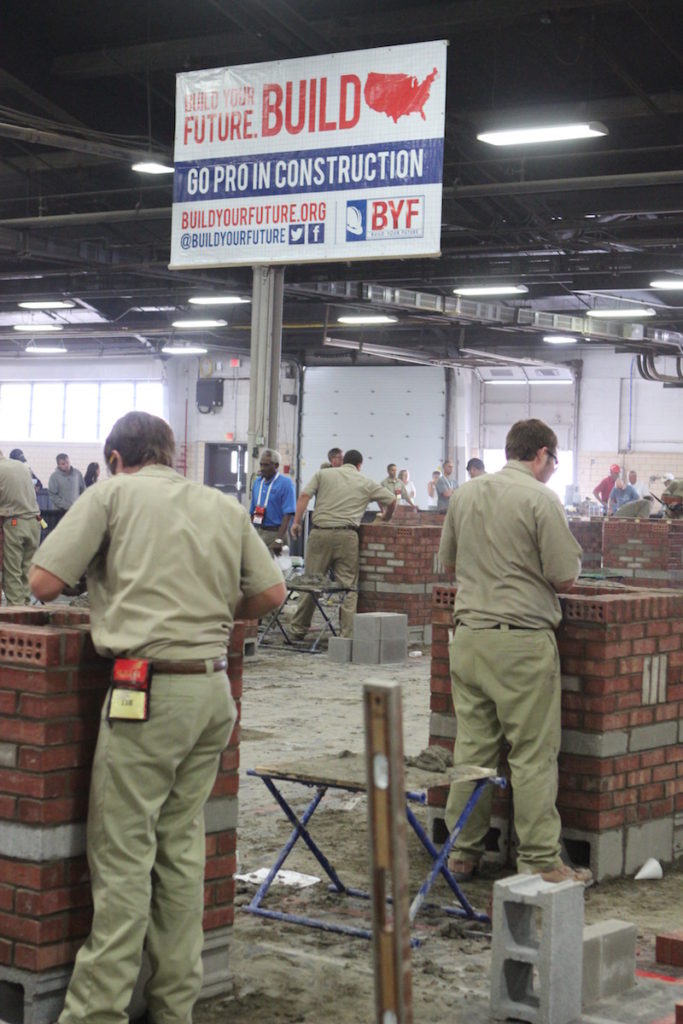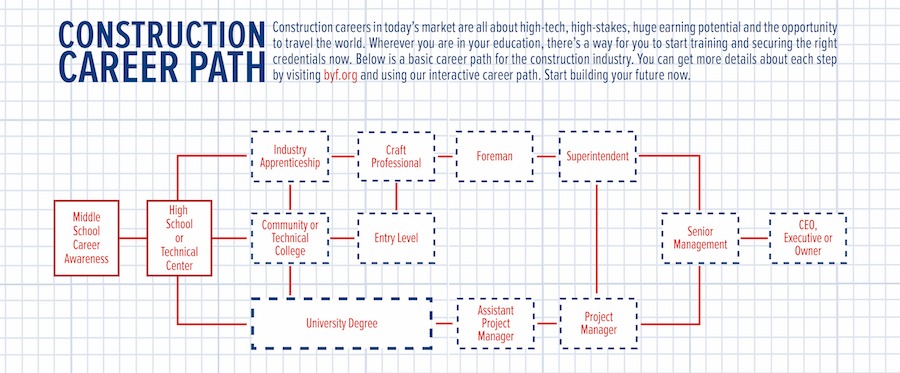When we were young, we built entire cities and neighborhoods from Legos and Lincoln Logs. Then, somewhere between childhood and adulthood, we were taught that it is more desirable to go to college, earn a degree and sit in cubicles for 40 hours a week than it is to build and fix things with our hands. Fortunately for many of us, there are still careers where builders thrive and earn more money than their cubicle counterparts and NCCER’s Build Your Future (BYF) initiative is committed to sharing the many opportunities for successful, lucrative careers in the construction industry with students across the country.
By taking a collaborative, grassroots approach to industry recruitment and image enhancement strategies, BYF is redefining the way the construction industry builds its talent pipeline. While great pay, the ability to travel the world and opportunities for advancement are all highly valued by the next generation of workers, few of them realize that a career as a craft professional meets all of the criteria. As part of the initiative, BYF developed three goals:
- Make career and technical education (CTE) a priority in secondary schools.
- Shift the public’s negative perception about careers in the construction industry to reflect the wide range of professions available.
- Provide a path from ambition, to training, to job placement as a craft professional.
With the “college for all” rally cry sweeping the nation, many individuals are unaware of the value of CTE programs or the opportunities for success that accompany a career in construction. Netflix portrays doctors, lawyers and corporate tycoons as America’s most successful professionals, but it is the men and women responsible for building society’s infrastructure that make modern life possible. So why is there a lack of interest from students eager to pursue fulfilling careers?
Unfortunately, today’s classroom routine, learn, memorize and repeat, makes it difficult to forge the connection between textbook material and real world application, leaving many unsure of their next steps after graduation. Interestingly enough, the Association for Career and Technical Education (ACTE) reports that 81% of high school dropouts say relevant, real-world learning opportunities would have kept them in high school. Therefore, BYF encourages the inclusion of CTE programs in schools across the country combining hands on learning with academic training. Students not only feel more prepared as they step into their first job, but they are able to build and refine their skill set from the very beginning.
In order to reach and interact with as many students as possible, BYF travels to numerous career days sharing the success stories of current craft professionals and encouraging educators and students to change the way they think about careers in the construction industry. In 2016, BYF attended 14 career days and interacted with 20,000 students, parents and teachers spreading the message about construction’s rewarding career opportunities. Surveys from 3,500 students showed that:
- 55% viewed construction careers more favorably after the event
- 85% had an increased interest in learning about careers in construction
- 44% of students are pursuing a career in construction after attending the event
From these numbers and the rising rate at which students are entering into college as “undecided” and “undeclared” majors, it is clear that students necessitate a great deal of information to make a well-informed, confident career path decision after high school. BYF’s famous career path highlights the many entrance points into the industry including industry training programs, community or technical college or a four-year university, and how each can be crafted to the lifestyle and learning style of each individual. By speaking with the students and hearing about their current perceptions of the construction industry, BYF can share the benefits of real world training in CTE programs and emphasize that in the construction industry, there is no right or wrong option as every path leads to a rewarding career.
BYF recognizes the unparalleled importance of education in the lives of students, but also believes that a valuable education is not confined to a college campus. BYF offers scholarships to support craft professionals and further their education and training and in 2016, $75,000 was divided amongst 48 students.
To further drive the partnership between education and industry, NCCER created a Connection Map that identifies educators, contractors, SkillsUSA organizations and ACTE state directors from across the country who are looking to collaborate locally based on shared interests and needs. Users are able to easily locate these groups and begin building partnerships to help support and grow our current and future workforce.
In addition to the Career Path and Connection Map, BYF provides numerous resources to educators, organizations and contractors looking to do their own recruiting. Items include bookmarks, posters and sample packs along with guides to plan career days and activities to celebrate Careers in Construction Month.
One of the most notable and highly sought after resources are the trading cards. With 32 different cards featuring craft professionals and various managerial positions, real men and women in the industry are featured along with their craft’s salary and educational requirements. Not only does this allow individuals to envision themselves underneath the hard hat, but it also encourages them to think of the many possibilities beyond a costly college degree and outlines the steps to get there.
BYF also works with individual states or organizations to develop customized partnerships that include utilizing an ambassador style program. One example of such success can be seen in the state of Indiana. The program has been featured in a Best Practice Profile for their commitment to understanding the state’s workforce shortage and exploring how best to spread the message about careers in construction. In 2014, the Indiana Construction Roundtable (IRC) began focusing on how to address the growing skills gap in their state. Shortly after, a taskforce was created and the Indiana Construction Roundtable Foundation (ICRF) was established. With the help of BYF, the state developed a partnership which includes customized marketing materials and a plan to help reach their state goals.
The ambassador program consists of skilled professionals who visit local high schools, share their stories, the value of construction careers and leave educational materials for the students. Since January of 2016, over 80 craft professionals have been trained, 52 high school presentations have been given and 20,000 individuals including students, teachers, parents, guidance counselors and other influencers have been reached. Build Your Future Indiana is a model example of just how powerful and influential sparking a conversation about careers in construction can be. Since its inception, CTE enrollments have increased and adult education programs are seeing more success at placing applicants.
Another major focus of BYF has been the birth and continued growth of Careers in Construction Month. Started by BYF in 2005, Careers in Construction Month was originally known as Careers in Construction Week. Due to tremendous response from organizations that recognized and supported Careers in Construction Week, BYF expanded its efforts by declaring October as Careers in Construction Month. This nationwide campaign was designed to increase public awareness of the opportunities available in the construction industry. In 2016, 28 states and the District of Columbia proclaimed October as Careers in Construction Month and BYF and NCCER are confident that number will continue to grow.
To increase engagement, BYF provides an extensive collection of free videos that can be used to recruit into the industry and change the public’s perception. This collection includes everything from GoPro videos to parents and counselors talking about why people should choose construction.
Another major focus of BYF has been fostering the connection between the military and construction. On Veterans’ Day 2016, NCCER released the first of its kind military credentialing portal as part of BYF’s military initiative known as Hard Hat Heroes. The Hard Hat Heroes Credentialing Portal allows veterans to receive NCCER credit for skills and training they already received while in the service. Individuals that meet the criteria can fill out the application online and submit documentation for review and potentially receive NCCER credentials. This service is provided completely free of charge.
Currently, alignments are available for 10 Army military occupational specialty (MOS) codes, 36 Seabee ratings and alignments for other military branches are in development. All alignments are developed in conjunction with military trainers and industry representatives. This initiative also aims to help employers understand and recognize the skills service members possess in various crafts. They can also be utilized as training plans to upgrade veterans’ skills once they are hired. By aligning objectives from military training with NCCER’s curricula, these alignments serve as a military-to-construction guide for employers and their human resource departments.
Overall, BYF is committed to revamping the image of the construction industry and providing students, educators and contractors with the resources necessary to pursue careers as craft professionals. Whether an individual is a self-starter, pioneer, take-charge leader or creative thinker, the construction industry offers opportunities and career paths to fit each and every personality. The information simply needs to be shared with the masses and BYF is that platform.
Our industry’s problem is clear: a skilled workforce shortage. So how do we effectively recruit the next generation of craft professionals when we are constantly competing against the four- year degree frenzy and construction’s portrayal as “dirty work”? We give students all of the resources and tools to build their own future and watch them build America.




